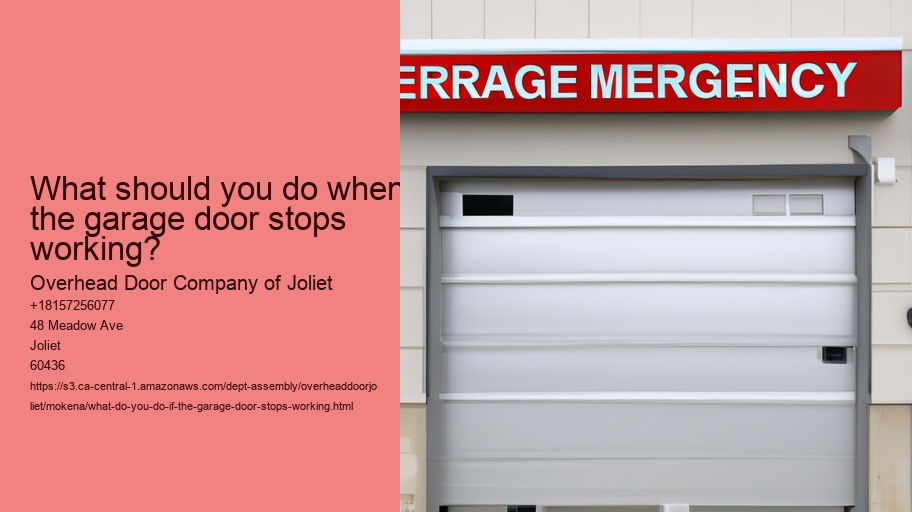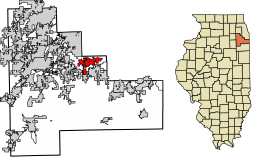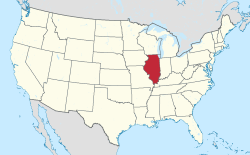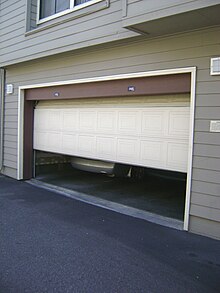Determine the Type of Garage Door and Opener
When garage doors suddenly stop working, it's an unpleasant and frustrating experience.Whether you're running for work or trying to get your car into the garage during a rainstorm or storm, a door that isn't working is not something you would want to confront with.The initial step to tackle the issue is to determine the kind of opener and garage door that you have, as this can greatly affect the way you approach solving the problem and fixing. What is the #1 Thing You Need to Do When Your Garage Door Suddenly Stops Working? .
Garage doors typically fall into a few categories based on their design and operation.The most popular varieties are roll-up, sectional and tilt-up doors.Sectional doors are made up of panel sections connected with hinges, which allow the door to bend as it opens and closes on vertical track.Roll-up doors, which are typically found in commercial settings, are constructed from sections of wood that are rolled up into coils.
The tilt-up door, on the contrary is a solid single piece that opens by tilting outward and up.Importantly, you must identify the kind of garage door opener.The three most common types are belt-drive, chain-drive and screw-drive openers.Chain-drive openers, that use an iron chain to raise and lower the door, are durable and affordable but they are noisy.Belt-drive openers function similarly, however they use a belt made of rubber that makes them more quiet and ideal for attached garages.Screw-drive openers move the door by using a threaded steel rod that provides a balanced balance between noise and cost.
The next step is to examine the garage door opener and identify the model. Make sure to check the plug and breaker to make sure that the opener is operating. Check the manual release cable and make sure that it hasn't pulled. This would result in the door being removed from the opener. Review the rollers and tracks of the door for damage or obstructions.
What do you do if the garage door stops working? - population density
- drawbar
- emergency service
- pride
If the door doesn't function, try resetting the opener.This will often fix electronic glitches or faults.Consult the manual of your opener for specific reset instructions, as this procedure can differ among models.Many modern openers come with a reset button, whereas others may require unplugging and plugging back in.
Spring tension is high and can cause danger to repair them if you don't have the proper tools.
In conclusion, if your garage door suddenly stops working you'll be able to tell it is
Look for any obstructions or debris.
It's frustrating and perplexing when your garage door ceases to function at a moment's notice, especially if utilize it regularly.
One of the primary and most efficient steps you can consider when you are faced in this scenario is to check for any obstructions or debris.This easy, yet efficient action can be a key to identifying the issue and returning functionality to the garage door.Even a tiny obstruction can prevent your garage door from functioning as it should.
Start by inspecting the tracks on both the left and right side of the door. Check for obvious obstructions or debris buildup. If you find anything unusual, such as the twig or rock that is stuck within the track. Remove it carefully.
There are times when the problem might not be obvious It is recommended to run your hand along the track to feel for any hidden obstacles.Ensure that the tracks are aligned properly too, since a misalignment can also result in the door becoming jammed.The next step is to inspect the rollers as well as hinges.These parts should be able to move without resistance.If they're squeaky or stuck, it could be the result of accumulation of dirt or rust.In such cases, cleaning and lubricating them is often a solution to the issue.Use a gentle cloth or brush to wash away any dirt and apply a suitable lubricant in order to make sure that the parts move smoothly.
Inspect the area that surrounds the door. Sometimes, objects within the garage could fall or move, creating obstacles for the door. Check that the area is free of obstructions and no objects that could block the door.
If, despite clearing any visible obstructions, the door does not work you should think about checking the sensors.
Modern garage doors come with security sensors that will stop doors from closing if something happens to be detected in its path.Make sure these sensors are in good condition and properly aligned, as the presence of dirt or misalignment could cause them to fail.If you are confronted with an garage door that suddenly isn't working, looking for obstructions or debris is an logical and frequently efficient first step.It will require only a few tools and knowledge, but it could save you money, time and also the hassle of calling a professional to fix what could be a straightforward fix.By making sure you have a clear pathway and
Inspect the Remote Control and Wall Switch
It's crucial to examine the wall switch and remote control.
These components are frequently the cause of an unresponsive garage door, and checking them can save you time and possibly avoid unnecessary costs.First, consider the remote control.This handheld device is your primary tool for operating the garage door without direct physical interaction.Over time, remote controls can experience issues such as drained batteries, signal interference, or even internal damage.Start by replacing the batteries with new ones.It might seem simple, but dead batteries are a common reason for a garage door not responding.If the problem persists after replacing the batteries, try reprogramming the remote according to the manufacturer's instructions.Additionally, ensure that the remote is within the recommended range and that there are no obstructions blocking the signal.
Next, turn your attention towards the wall switch. It is a essential component in the garage door's design.
The wall switch is linked to the garage door opener and often provides a more reliable method of operation.Inspect the switch for any evidence of physical damage or wear.Sometimes, loose wires or connections that are not working correctly can cause the switch to malfunction.If you are able to do so, carefully open the switch panel to check for damaged or broken wires.If any issues are found, it may be necessary to speak with a professional electrician to safely deal with the issue.In certain instances, the wall switch could appear to be functioning, yet the door remains unresponsive.This could suggest an issue in the garage door opener itself or other parts like sensors or door tracks.However beginning by utilizing the wall switch and remote control is an appropriate first step.
You can eliminate these issues before you begin more intricate troubleshooting.In the end, examining the remote control and wall switch in the event that your garage door suddenly stops functioning is a practical and straightforward approach.By checking these parts first, you can quickly determine if the issue lies in these easy to access parts or if further investigation is needed.This initial inspection does not only cut down on time, but also gives peace of mind knowing that you've taken all the proper steps to determine the issue in a timely manner.
Manually test the door balance
What do you do if the garage door stops working? - customer service
- Victor J. Andrew High School
- population density
- customer service
If the garage door stops working, it can be both painful as well as inconvenient.The garage door is an an essential part of your house, offering security, protection from the elements, and a simple access to your vehicle as well as storage area.
One critical step you should do when confronted with the problem of a garage door that is not working is to examine the door's balance.This easy, yet efficient procedure will help identify potential problems and help prevent further damage to the door or its components.A garage door's balance is critical to its correct operation. An imbalanced door can cause more serious problems like misalignment or broken springs.
To check the door's balance, begin by disconnection of the garage door opener.
The majority of garage doors come with a release system that is found on the red cord or the handle. After the door has been unplugged from the motor, you can lift it to waist-high and then release it. A properly balanced door will stay in place and move in a gradual manner.If you observe that the door is not properly balanced it is essential to fix the problem promptly.Door balance problems are typically related to tension in the springs, which can be dangerous to adjust yourself due to the pressure they are under.It is recommended to consult a professional for assistance in adjusting the springs and ensure the door is properly balanced correctly.Doing this will not only solve the immediate problem but also will increase the longevity and stability of your garage door's system.
The manual testing of the balance of your garage door is a critical first step to take when it suddenly ceases to function.
This method helps identify whether the problem lies in the balance of the door or elsewhere within the system.By understanding the importance of balancing your door and taking care to address any issues quickly it will prevent any further damage and ensure that your garage door is operating in a safe and efficient manner for years to come.Tracks and Rollers
When confronted with a garage door that suddenly ceases to work, your first response is to worry or consider the most difficult technical issues.However it is often the answer is in a straightforward inspection of the tracks and rollers.This vital check could make a difference in time and cost-intensive repair expenses which is why it's the first thing you should prioritize in the event that your garage door ceases working.
The rollers and tracks are the key components of your garage door's operating system.The tracks are the steel rails that help guide the door as it opens and closes, while the rollers are the small wheels which move along the tracks.
Over time, these parts can become dirty, misaligned or worn-out, resulting in operational problems.Begin by checking the track for any obstructions. Grime, dirt or even small pieces of debris can get accumulated, causing the rollers to struggle to travel across the track. Cleansing the tracks with an aqueous cloth will resolve this problem.
Next, examine the alignment of the tracks.Tracks must be aligned and parallel to each other.If they appear bent or out of alignment, your door may jam.You can gently tap the misaligned portions back into position using a rubber mallet.However, if the damage is extensive then it is recommended to contact a professional to re-align them in a safe way to ensure security and function.
Checking the rollers is equally important.Over time, the rollers could wear out or become damaged particularly if made of plastic.
Check for indications of wear and tear, such as cracks or chips.If the rollers seem worn, think about replacing them with new ones.Metal rollers equipped with ball bearings tend to offer more durability and smoother operation.Applying silicone-based lubricants can decrease friction and wear. Be sure to grease the springs and hinges for ensuring that your garage door works efficiently.
When you make sure that the components are properly aligned and lubricated, it is possible to get the garage door back to its full functionality.
Taking the time to periodically check and maintain the parts will help avoid any future issues, extending the lifespan of your garage door system.Examine for visible damage or wear
It can be a hassle and inconvenient when your garage door stops operating abruptly, especially if you're on your way home, or trying to lock the house for the night.
Garage doors are a complicated system made up of many parts, such as springs, cables and rollers all of which play a crucial role in the smooth operation.Over time, these components are prone to wear and tear from regular usage and exposure to the environmental elements.
If you conduct a thorough visual examination, you will be able to identify any obvious signs of damage that could be causing the door to malfunction.Start by inspecting the springs. They are responsible for lifting and lower the door. Examine for indications of wear or rust. A worn out spring could render the door inoperable, therefore it's crucial to repair this issue as soon as possible. Next, check the cables for fraying or broken strands.
The door is another place that requires the attention of a professional. Check for obvious dents, warping, or bends.
Furthermore, ensure that the sensors of the door are in good condition and aligned because misalignment or dirt could hinder their work and make the door stop functioning.What do you do if the garage door stops working? - Victor J. Andrew High School
- Ashburn
- manufacturing
- Cahokia
While a visual inspection could give valuable information However, it's important to consider that some problems might not be immediately apparent.If you do not find any obvious signs of damage or wear, it might be necessary to talk with a professional to pinpoint and address the problem.However through an initial inspection, it is possible to find and correct minor problems before they escalate into more serious and costly repairs.
If you're confronted by a malfunctioning garage door, searching for obvious wear or damage is the most important first step.This approach not only helps to identify the issue fast but also enables you to take the necessary action for restoring the door to working properly.
If you are proactive and alert, you can ensure the longevity and durability of your garage doorCheck the Springs and Cables
When your garage door suddenly stops working, it can be both difficult and inconvenient.One of the most vital steps you need to take in this scenario is to examine the springs as well as cables.These elements are essential for the proper functioning of your garage door and problems with them are usually the root cause behind broken door.
The springs play a crucial part in the functioning and ease of your garage by neutralizing the load. There are two primary types of springs, extension and torsion. Torsion springs are positioned above the garage and twist in order to store energy. Extension springs however are installed on either side of door and extend to provide necessary force.
Over time the springs wear out, break or loose tension, leading to issues with operation.The cables may also be damaged by wear and tear. They may fray or snap under the pressure.
If you are evaluating the springs or cables, begin by visually inspecting them.Look for signs of rust, wear, or fraying.If you find a damaged cable or spring you should avoid using the door until the issue is resolved, as forcing it might cause further injury or result in an accident.If springs look in good shape however, the door is not functioning, it could be because they've lost tension and require adjustment.
It's vital to focus on safety when dealing with garage door parts.
Cables and springs are held at pressure and could result in serious injury in the event that they are mishandled.If you're not a pro at garage repair, it's best to consult a professional technician.They have the necessary equipment and experience to replace or repair these parts making sure your garage door operates properly and safely.In conclusion, when your garage door suddenly stops working, assessing the springs and cables is a key step in diagnosing the problem.Understanding their role and potential issues can help you determine whether a simple adjustment is needed or if professional intervention is required.Taking prompt action not only restores functionality but also ensures the safety and longevity of your garage door system.
You might want to consider calling a professional technician
When your garage door suddenly stops working and it is not working, it could disrupt your day or even create the risk of a security threat to your home.
It is tempting to get the toolbox and try to fix by yourself however it is better to seek out a professional. This choice is not just about your safety, but also give you a long-lasting and more effective solution.Garage doors are complex systems composed of various components such as springs, cables, tracks, and electronic parts.Each of these elements plays a crucial role in the door's operation, and a malfunction in any part can cause the entire system to fail.Without proper knowledge and experience, attempting to fix these issues can be dangerous.For instance, garage door springs are under high tension and can cause severe injury if handled improperly.Professional technicians are trained to deal with these risks safely, using the right tools and techniques to handle repairs.
In addition, a technician who is a professional brings expertise and experience that a layperson does not possess.
They can quickly diagnose the issue and identify whether it's a minor problem, like a misaligned track, or something more serious, like a broken spring.This expertise not only saves you time but also prevents the potential for further damage that can occur with incorrect handling.Professionals also have access to high-quality parts and can ensure that replacements match the specifications of your existing garage door system, leading to better functionality and longevity.A skilled technician can be cost-effective over the long haul. Although a DIY option may appear more affordable at first however, it could lead to extensive and expensive repairs later.
Many technicians also provide guarantees on their work, which gives you peace of knowing that should something go wrong, you are covered.Then, contacting a expert can save you considerable time and hassle.Trying to master the intricate details of garage door mechanics and purchase the proper tools, and then execute an repair can be time-consuming and take days.In the opposite, a professional can usually resolve the issue swiftly, allowing you resume your daily routine without delay.
While the desire to repair your garage door yourself may be powerful, contacting a professional technician is the safest best, most efficient, and in the end, the most practical option.Their skills, experience in locating quality parts, and the ability to complete quick and precise repairs will ensure that your garage door is repaired and running smoothly again, protecting both your property as well as your family.


















